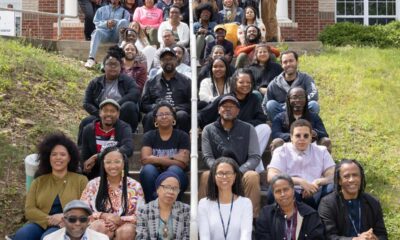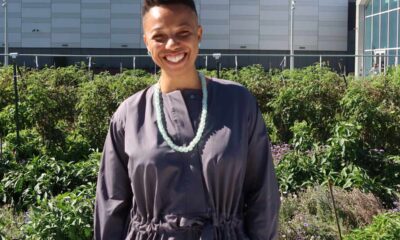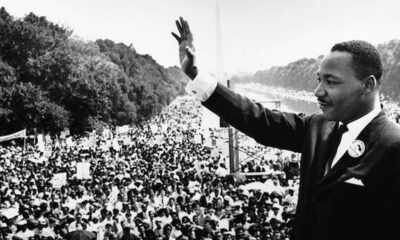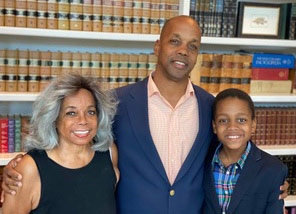Environment
Climate Change is a Crisis for Black Communities

By Fern Gillespie
This July, for the first time in nearly two years, the National Weather Service issued an extreme heat advisory for New York City. “Heat kills more New Yorkers every year than any other kind of extreme weather event. Access to cooling is a matter of life and death,” Mayor Eric Adams announced recently.
According to the NYC Environment and Health Data Portal, the Heat Vulnerability Index (HVI) shows neighborhoods whose residents are more at risk for dying during and immediately following extreme heat. A dangerous high HVI is 5.
Black neighborhoods in Brooklyn, Brownsville, East New York, and Coney Island rank 5, and parts of Bed Stuy, Flatbush, and Crown Heights rank 4.
“Between 500 and 800 people lose their lives in the New York area each year due to extreme heat. Of that number 50 percent are Black,” Anthony Rogers-Wright, Director of Environmental Justice at New York Lawyers for the Public Interest told Our Time Press yesterday. “It’s definitely a function of the neighborhood that they live in. Neighborhoods that have less tree cover. They tend to have a lot more concrete. That also creates an oven effect. Lack of good housing that doesn’t allow for cool air to stay in the house and that isn’t equipped with air conditioning.”

According to various polls, climate change is a major issue for Black people. Black people would score higher than whites for caring about climate change and what the government is doing about it. Rogers-Wright has worked with Black communities like Coney Island on the impact of flooding neighborhoods. “When the events happen, we know that FEMA tends towards making better claims to white wealthier people than to Black, Brown, and poor people,” he explained.

The aftermath of the Superstorm Sandy crisis was a long recovery for Black Brooklynites in Coney Island. “The legacy of practices like redlining and other ghettoization that typically put poor, particularly Black and Brown people, in lower-lying neighborhoods that are more prone to flooding,” he said. “These are areas that Black, Brown, and poor people were forced into. They were more disconnected from city services. What we’re seeing now is climate change is really exposing the severity of many of our social services like healthcare, racial justice, economic justice, all of it. The infrastructure is being exposed at the same time.”
President Biden is listening more that the previous president to how the climate crisis is affecting BIPOC. He has appointed veteran environmentalist Michael Stanley Regan as the administrator of the Environmental Protection Agency who is the first African American man in that position. The President has also indicated that, through some infrastructure programs, Black and brown and poor communities would be prioritized. “But, in this year of change, programs have been passed and ratified, but we still have not seen the impact of it benefiting primarily the communities that are mostly impacted by the common crisis,” said Rogers-Wright, who advises communities on being frontline advocates confronting the effects of the climate crisis.
“I help people get involved through the voting process, putting pressure on the lawmakers, even how to direct action PACs to ensure their community is no longer being poisoned or being selected as places where they put garbage or where all of our floodwaters go,” he said. “We are just agents and tools of the communities. At times when it’s necessary we absolutely will utilize the power of litigation led by the community to end a practice or force the government to begin a practice. Be it removing lead water pipes or ensuring the flood-prone areas are better protected.”
Dr. Lauren A. Smalls-Mantey Senior Environmental Systems Scientist, Bureau of Environmental Surveillance and Policy, New York City Department of Health and Mental Hygiene specializes in spatial and climate change. “Heat is the deadliest of all extreme weather events in the US and in New York City. More than 60 percent of heat stroke deaths in recent years involved people who were exposed to heat in homes without air conditioning,” she told Our Time Press. “The best way to prevent heat illness is to stay in a cool, air-conditioned place. A fan is not enough.”
When the Canadian wildfire swept through New York City this June, people with respiratory and heart problems became more aware of the Air Quality Index, which topped a harrowing 484. A good AQI is 0 – 50 and moderate is 51 -100.
“The Air Quality Index helps people make decisions on how intense and when to exercise outdoors and when to take it easy,” said Dr. Smalls-Mantey. “New Yorkers with existing health conditions can talk with their doctor about how poor air quality or extreme heat may impact them. And people can develop a plan on how to get to or stay in an air-conditioned place on hot days and when NYC experiences hot days and poor air quality at the same time.”
City officials encourage New Yorkers to seek out air-conditioning indoors at libraries, movie theaters, museums, and malls and outdoors at public swimming pools, splash pads, and shady parks. The city is partnering with Petco to provide cooling centers for pets. All local cooling centers can be found by calling at 311.













